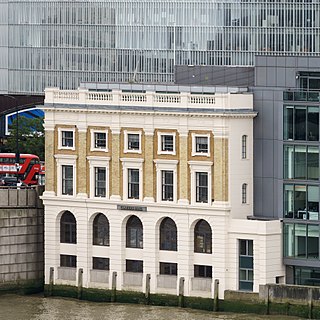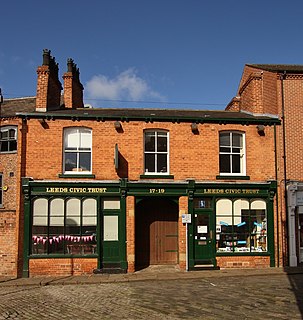Related Research Articles

The National Trust for Places of Historic Interest or Natural Beauty, commonly known as the National Trust, is a charity and membership organisation for heritage conservation in England, Wales and Northern Ireland. In Scotland, there is a separate and independent National Trust for Scotland.

The International Union for Conservation of Nature is an international organization working in the field of nature conservation and sustainable use of natural resources. It is involved in data gathering and analysis, research, field projects, advocacy, and education. IUCN's mission is to "influence, encourage and assist societies throughout the world to conserve nature and to ensure that any use of natural resources is equitable and ecologically sustainable".

The Woodland Trust is the largest woodland conservation charity in the United Kingdom concerned with the creation, protection, and restoration of native woodland heritage. It has planted over 50 million trees since 1972.

The Department for Digital, Culture, Media and Sport (DCMS) is a department of the United Kingdom government, with responsibility for culture and sport in England, the building of a digital economy, and some aspects of the media throughout the UK, such as broadcasting and Internet.

The Worshipful Company of Glaziers and Painters of Glass is one of the Livery Companies of the City of London. The Guild of Glaziers, or makers of Glass, the Company's forerunner, existed as early as 1328. It received a Royal Charter of incorporation in 1638. It is no longer a trade association of glass craftsmen, instead existing, along with a majority of Livery Companies, as a charitable body.

The Prince's Trust is a charity in the United Kingdom founded in 1976 by Charles, Prince of Wales, to help vulnerable young people get their lives on track. It supports 11 to 30-year-olds who are unemployed and those struggling at school and at risk of exclusion. Many of the young people helped by The Trust are in or leaving care, facing issues such as homelessness or mental health problems, or have been in trouble with the law.
The Wordsworth Trust is an independent charity in the United Kingdom. It celebrates the life of the poet William Wordsworth, and looks after Dove Cottage in the Lake District village of Grasmere where Wordsworth and his sister Dorothy Wordsworth lived between 1799 and 1808. It also looks after the majority of the surrounding properties in the conservation area of Town End, and a collection of manuscripts, books and fine art relating to Wordsworth and other writers and artists of the Romantic period. In 2020 it introduced the brand name Wordsworth Grasmere.

Fields in Trust, is a British charity set up in 1925 as the National Playing Fields Association (NPFA), by Brigadier-General Reginald Kentish and the Duke of York, later King George VI, who was the first president, which protects parks and green spaces and promotes the cause of accessible spaces for play, sports and recreation in British cities and towns.

The Churches Conservation Trust is a registered charity whose purpose is to protect historic churches at risk in England. In practice, the Trust works to prevent any deterioration in the condition of the buildings in its care and to ensure they are in use as community assets. Local communities are encouraged to use them for activities and events and the buildings provide an educational resource, allowing children and young people to study history, architecture and other subjects.

The Indian National Trust for Art and Cultural Heritage (INTACH) is a non-profit charitable organisation registered under the Societies Registration Act, 1860.
The United Kingdom Antarctic Heritage Trust (UKAHT) is a British charity, registered in 1993 and re-registered in 2015. The UKAHT is a member of the Antarctic Heritage Trust coalition. The UKAHT's Patron is Princess Anne, The Princess Royal.
The International Institute for Conservation of Historic and Artistic Works (IIC) is a global organisation for conservation and restoration professionals with over two thousand members in over fifty countries. IIC seeks to promote the knowledge, methods and working standards needed to protect and preserve historic and artistic works throughout the world.
Allchurches Trust is a large national charity in the United Kingdom, established in 1972. It is headquartered in Gloucester. It is an independent registered charity. Its objects are to promote the Christian faith and to contribute to the funds of any charitable institutions and to carry out any charitable purpose. Initially, most of its grants were for the repair and maintenance of church buildings. Now it also supports projects that more widely benefit local communities and reflect changes in society.
The Clwyd-Powys Archaeological Trust(CPAT) is an educational charity which was established in 1975. Its objective is ‘to advance the education of the public in archaeology’. CPAT is one of four Welsh Archaeological Trusts (WATs) which work to help protect, record and interpret all aspects of the historic environment. This includes providing advice to local authorities on archaeology and planning, undertaking archaeological projects for private- and public-sector clients, and delivering a programme of community archaeology events and activities.

The Gore Hill Memorial Cemetery is a heritage-listed cemetery located on the Pacific Highway, Gore Hill, St Leonards in the City of Willoughby local government area of New South Wales, Australia. It was established on 19 May 1868 by the New South Wales politician, William Tunks, and is one of the oldest and most significant remaining cemeteries in metropolitan Sydney. The first interment was in 1877, and until its closure for burials in 1974, 14,456 burials took place. Most burials took place between 1900 and 1930. It is also known as the Gore Hill Cemetery. The cemetery is situated on Crown land and is managed by a not for profit community organisation, Northern Cemeteries, through a Board of Trustees. It was added to the New South Wales State Heritage Register on 25 May 2001.

Leeds Civic Trust is a voluntary organisation and registered charity established in Leeds, West Yorkshire, England in 1965. Affiliated to the national charity Civic Voice, its stated purpose is "to stimulate public interest in and care for the beauty, history, and character of the city and locality, to encourage high standards of design, architecture and town planning; [and] to encourage the development and improvement of features of general public amenity".

The Bumblebee Conservation Trust is an organisation in the UK that makes efforts to monitor and conserve bumblebees and their habitat.

The National Churches Trust, formerly the Historic Churches Preservation Trust, is a British registered charity whose aim is to "promote and support church buildings of historic, architectural and community value across the UK". It carries out this aim by providing financial grants to repair and modernise church buildings, supporting projects to enable churches to remain open, collaborating with local Churches Trusts and volunteer bodies, providing practical advice, support and information, and working to promote public awareness of the needs of churches. Its forerunner was the Historic Churches Preservation Trust, whose functions it has taken over, together with those of the Incorporated Church Building Society.

The Royal Foundation of The Duke and Duchess of Cambridge is a charity which supports the work of the Duke and Duchess of Cambridge. Their projects revolve around conservation, the early years, mental health, and emergency responders.

The Rufford Foundation, formerly the Rufford Maurice Laing Foundation, is a trust based in the United Kingdom that funds nature conservation projects by small or medium-sized organizations in developing countries.
References
- ↑ "War Memorials Trust: Review of Activities; Administration, publications and PR" (PDF). Charity Commission. p. 8. Retrieved 7 February 2017.
- ↑ Objectives War Memorials Trust. Retrieved 2019-05-21.
- ↑ War Memorials Trust, Charity framework. Charity Commission. Retrieved 2012-03-23.
- ↑ History. War Memorials. Retrieved 2012-01-05.
- ↑ War Memorials Trust, Charity Framework Charity Commission. Retrieved 2017-02-01.
- ↑ Logo. War Memorials. Retrieved 2012-01-05.
- ↑ Trustees' report and accounts, Review of activities: Conservation, p7. Charity Commission. Retrieved 2019-05-21.
- ↑ First world war centenary brings revival in memorial restorations . The Guardian. Retrieved 2019-08-16.
- ↑ War memorial is restored as part of £2.7m Poole Park Life project. Bournemouth Echo. Retrieved 2019-08-8.
- ↑ Heritage Funding Directory. Heritage Alliance. Retrieved 2017-02-01.
- ↑ Social Change Awards winners announced. Charity Times. Retrieved 2019-06-11.
- ↑ Trustees' Report and Accounts, Review of Activities: Conservation, p5. Charity Commission. Retrieved 2019-05-21.
- ↑ Millions of pounds to support restoration and repair of First World War memorials. GOV.UK. Retrieved 2019-06-11.
- ↑ MDetails of £5 million fund to repair, protect, and conserve First World War memorials revealed. GOV.UK. Retrieved 2019-06-11.
- ↑ Conservation Principles. War Memorials Trust. Retrieved 2019-06-11.
- ↑ Grants. War Memorials Trust. Retrieved 2019-06-11.
- ↑ Isle of Lewis War Memorial Restoration. Stornoway Gazette. Retrieved 2019-08-08.
- ↑ Building Briefs – October 9th. Scottish Construction Now. Retrieved 2019-08-08.
- ↑ Cardiff Newsroom. Retrieved 2019-0808.
- ↑ Renovated memorial to pay tribute to village's war dead. Impartial Reporter. Retrieved 2019-08-16.
- ↑ Trustees' report and accounts, Review of activities: Conservation, p6. Charity Commission. Retrieved 2017-03-28.
- ↑ About the Project. War Memorials Online. Retrieved 2019-05-21.
- ↑ Free Smartwater crime reduction protection for war memorials. Doncaster Free Press. Retrieved 2017-02-01.
- ↑ Frances Moreton: We must all protect memorials to the fallen. Yorkshire Post. Retrieved 2012-03-23.
- ↑ 'Smartwater' helps protect war memorials. Stockton Town Talk. Retrieved 2012-04-10.
- ↑ Smart thinking to protect Stockton war memorials. Evening Gazette. Retrieved 2012-04-10.
- ↑ Hi-tech move to protect Stockton war memorials. BBC News. Retrieved 2012-04-10.
- ↑ A smart way to foil war memorial metal thieves. The Northern Echo. Retrieved 2012-04-10.
- ↑ Smart guarding against thieves. Lytham St Anne's Express. Retrieved 2012-04-10.
- ↑ Protection for war memorials from metal thieves. Hucknall Dispatch. Retrieved 2012-04-10.
- ↑ Plaques marked to stop scrap thefts. Nottingham Post. Retrieved 2012-04-10.
- ↑ Barr Beacon in Walsall to get £440,000 revamp. BBC News Birmingham and Black Country. Retrieved 2012-04-10.
- ↑ Join the Smart brigade and protect your war memorial. Nottingham Post. Retrieved 2012-04-10.
- ↑ Action urged in plan to protect war memorials from 'upsetting' thefts. Derby Telegraph. Retrieved 2017-02-07.
- ↑ Derbyshire British Legion backs protecting war memorials. BBC News Derby. Retrieved 2012-04-10.
- ↑ Ellesmere's smart response to PM's memorial concerns. Border Counties Advertiser. Retrieved 2012-04-10.
- ↑ Marker plan to protect Borders war memorial. The Southern Reporter. Retrieved 2012-04-10.
- ↑ Stolen Carshalton war memorial plaques replaced. BBC News London. Retrieved 2012-04-10.
- ↑ War memorials get invisible security markings as campaign against metal thieves stepped up. Sutton Guardian. Retrieved 2012-04-10.
- ↑ First World War centenary: Crumbling war memorials to be conserved through £3 million repair fund. The Telegraph. Retrieved 2017-02-07.
- ↑ Trustees' Report and Accounts, Review of Activities: Conservation, p6. Charity Commission. Retrieved 2017-02-07.
- ↑ What War Memorials Trust's Learning Programme does. Learn About War memorials. Retrieved 2012-07-16.
- ↑ History of the Learning Programme. Learn About War memorials. Retrieved 2019-08-16.
- ↑ Report and Accounts, Review of Activities: Administration, publications and PR, p9. Charity Commission. Retrieved 2019-06-11.
- ↑ University of Kent. Retrieved 2017-02-07.
- ↑ Trustees' Report and Accounts, Review of activities: Volunteers, p8. Charity Commission. Retrieved 2019-06-11.
